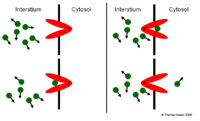Transport Proteins - Physiology
Jump to navigation
Jump to search
|
|
Introduction
Transport proteins allow hydrophillic molecules, which are too large to get through water filled protein channels, to passively cross the membrane. The molecules bind to protein and then the protein changes shape depositing the molecule at the other side of the membrane. This transport method is also known as Facilitated Diffusion. As with diffusion it occurs from areas of high concentration to those of low.
Differances Compared to Diffusion
- The proteins are very specific to very few molecules
- The proteins have a maximal rate. If the concentration of the molecule to be transported is very high the number of proteins is likely to limit the rate.
- Some of the proteins bind a small number of differant molecules. These molecules will compete for the proteins and will be transported in similar relative quantites to their original concentrations.
Transport Proteins and Active Transport
Transport proteins can take part in facilitated diffusion which is a passive process or they can be involved in Active Transport
